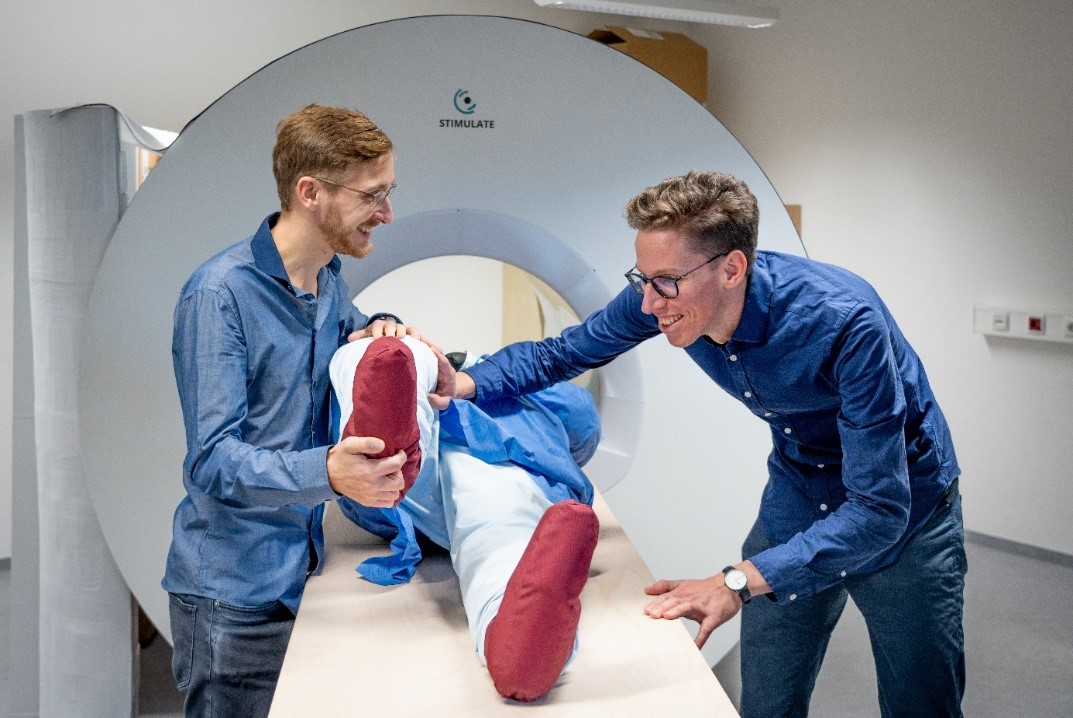NEWS
Erprobung des neuen STIMULATE Usability Labors
Am Forschungscampus STIMULATE ist das neue iMRI-Usability-Labor für die Analyse von Operationen mithilfe des bildgebenden Verfahrens der Magnetresonanztomographie (iMRI) in einer ersten Evaluation erfolgreich zur Untersuchung interventionell-radiologischer Eingriffe eingesetzt worden.
Ein Usability-Labor dient zur kontrollierten Simulation und Untersuchung klinischer Arbeitsabläufe, um Herausforderungen, Probleme und Bedienungsschwierigkeiten medizinischer Geräte zu identifizieren. Ein solches Usability-Labor - spezialisiert auf die Arbeitsabläufe in der interventionellen Radiologie - wurde am Forschungscampus in Kollaboration zwischen der Otto-von-Guericke-Universität Magdeburg, dem Unternehmen USE-Ing. GmbH und der Medizinische Hochschule Hannover konzipiert und aufgebaut.
Das Labor besteht aus einem simulierten Interventionsraum, der ein interaktives Modell eines MRT-Geräts beinhaltet, einem MRT-Kontrollraum und einem Beobachtungsraum zur Überwachung und Aufzeichnung der simulierten Arbeitsabläufe. In diesem Setup können sowohl Arbeitsabläufe einzelner Kliniker:innen, als auch Workflows ganzer klinischer Teams untersucht werden. Dabei können verschiedene Forschungsdaten aufgenommen werden. Neben Audio- und Videoaufzeichnungen aus bis zu sechs Perspektiven ist die Analyse von Eye-Tracking- und Motion-Tracking-Daten für bis zu zwei Versuchsteilnehmer:innen möglich. Eye-Tracking beschreibt die Blickrichtung von Versuchspersonen und erlaubt Rückschlüsse darauf, wann Proband:innen sich für welche Informationen interessieren. Motion Tracking ist die Messung der Bewegung von Personen im Raum. Damit lassen sich zum Beispiel wertvolle Daten über die ergonomischen Eigenschaften technischer Systeme erheben.
Im Rahmen einer Zwischenevaluation wurde eine erste erfolgreiche Erprobungsstudie des Labors mit drei interventionellen Radiologie-Teams (Radiolog:in und Medizinisch-technische Radiologieassistent:in) durchgeführt. Dabei wurde die minimal-invasive, MRT-gestützte Entnahme von Leberbiopsien simuliert und eine Bandbreite der beschriebenen Forschungsdaten aufgenommen.
Neben der Forschungsinfrastruktur für externe Kollaborationspartner des Forschungscampus stellt das Labor zuvorderst eine wertvolle Möglichkeit für eigene Forschungs- und Entwicklungsprojekte dar. So können Forschungsprototypen innovativer, interaktiver Medizingeräte unter realistischen und kontrollierten Bedingungen direkt im Speicher B Gebäude des Forschungscampus im Wissenschaftshafen Magdeburg getestet und evaluiert werden.
Abbildung: Zwei Wissenschaftler bei der Demonstration von Operationsabläufen am klinik-getreuen MRT-Modell im neuen STIMULATE Usability Labor.
Picture: Two scientists demonstrating surgical procedures on a clinic-like MRI model in the new STIMULATE usability lab.
Testing the new STIMULATE Usability Lab
At the Research Campus STIMULATE, the new iMRI usability laboratory for the analysis of operations using the imaging method of magnetic resonance imaging (iMRI) has been successfully used in an initial evaluation to investigate interventional radiology procedures.
A usability laboratory is used for the controlled simulation and investigation of clinical workflows in order to identify challenges, problems and operating difficulties of medical devices. Such a usability laboratory - specializing in workflows in interventional radiology - was designed and set up at the Research Campus in collaboration between Otto-von-Guericke-University Magdeburg, the company USE-Ing. GmbH and Hannover Medical School.
The laboratory consists of a simulated intervention room containing an interactive model of an MRI machine, an MRI control room and an observation room for monitoring and recording the simulated workflows. In this setup, workflows of individual clinicians as well as workflows of entire clinical teams can be examined. Various research data can be recorded. In addition to audio and video recordings from up to six perspectives, it is possible to analyze eye-tracking and motion-tracking data for up to two test participants. Eye tracking describes the direction of gaze of test subjects and allows conclusions to be drawn about when test subjects are interested in which information. Motion tracking is the measurement of the movement of people in space. This can be used, for example, to collect valuable data on the ergonomic properties of technical systems.
As part of an interim evaluation, a first successful trial study of the laboratory was carried out with three interventional radiology teams (radiologists and medical-technical radiology assistants). The minimally invasive, MRI-assisted removal of liver biopsies was simulated and a range of the research data described was recorded.
In addition to the research infrastructure for external collaboration partners of the Research Campus, the laboratory is first and foremost a valuable opportunity for in-house research and development projects. For example, research prototypes of innovative, interactive medical devices can be tested and evaluated under realistic and controlled conditions directly in Building Storage B of the Research Campus within Magdeburg’s Port of Science.
